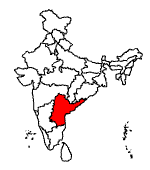
Dimdima
Online Children's Magazine from India

Dimdima
Online Children's Magazine from India
Area : 2,75,068 sq.km. divided into 23 districts.
Population : 7,61,11,243
Languages : Telugu and Urdu.
Capital : Hyderabad
Twin city :
A former British cantonment, Secunderabad is separated from Hyderabad by the Hussain Sagar Lake.
Commercial Centre :
The 2000-year-old city, Vijayawada situated between the river Krishna and its tributary, Budameru. It is a major railway junction.
Geography :
Lies on the high eastern Deccan Plateau which slopes towards the east coast where the state's major rivers, the Godavari and the Krishna, with its tributary Tungabhadra, make fertile deltas before joining the Bay of Bengal.
Climate :
Hot and humid. On July 7, 1997, Visakhapatnam recorded a temperature of 39.600C, the highest in 100 years.
Major Port : Visakhapatnam, once a small fishing village named after Visakha, the god of valour, is the largest ship building centre in the country and the Eastern headquarters of the Indian Navy.
Rainfall :
110-125 cm annually in the northern areas and 50 cm in the southern parts. Coastal areas are lashed by cyclones during the monsoons, which occur in winter.
At the time of Independence, Telugu-speaking people were distributed in about 21 districts in South India. Twelve of these districts formed part of the Madras Presidency and the other nine constituted the princely state of Hyderabad which was ruled by the Nizam.
The Nizam sought to become an independent ruler after the British had left India. But the tide of history was against him and after a brief 'police action' in 1949, Hyderabad became a part of the Indian Union.
Andhra came into being on October 1, 1953. It was formed from Telugu-speaking areas that were separated from Madras Presidency. The capital was Kurnool.
It was the first state formed on the basis of language.
Later, the nine districts that had been ruled by the Nizam were added to the state and the present-day Andhra Pradesh was established on November 1, 1956.
Hyderabad became the capital of the new state.
The Glory of Andhra
The Satavahanas (230 B.C. - 200 A.D.), the oldest of the dynasties that ruled over South India, were Andhras. They held sway over the whole of the Deccan and far into Northern India.
Krishnadevaraya, the most distinguished ruler of the Vijayanagara empire in the south, was also of Andhra origin. A patron of art and literature, he was the author of a poetic work in Telugu.
The Kakatiyas were the other famous rulers of Andhra.
The last of the famous dynasties that ruled in this region was the Qutubshahi dynasty. They built the Golconda fort and the city of Hyderabad.
Hyderabad's famous landmark, the 55-metre high Charminar, was built in 1591 by Sultan Muhammad Quli to commemorate the end of plague.
The Hussain Sagar Lake which divides Hyderabad and Secunderabad has in its midst the 350 tonne, 16- metre high statue of Buddha.
The historic fort of Golconda, once the headquarters of the Qutb Shahi Sultans, has a unique acoustics system : a clap at the entrance below can be heard in the Darbar Hall atop the hill. Golconda was considered impregnable but fell to Aurangzeb.
One of the highest masonry dams in the world, the Nagarjuna Sagar built in 1960, is at a site which was once an ancient Buddhist settlement, Nagarjuna Konda.
The 3560 sq km Nagarjuna-sagar Srisailam Sanctuary is the largest tiger reserve in India.
Built in the 12th century by Raja Rajendra, a Chola king, the Vayudeva temple in Sri Kalahasti is the only shrine in the country dedicated to the god of wind, Vayu.
The 16th century Veerabhadra Temple in Lepakshi has pillars that do not quite touch the ground. One can pass a cloth between the underside of the pillar and the floor.
The richest temple in the country, the Tirupati temple perched at a height of 860 metres on the Tirumala Hills in the Chittoor district has the 2-metre high statue of Lord Venkateswara or Sri Balaji standing on a lotus. A gold-covered Vimana adorns the sanctum sanctorum.
The classical dance form, Kuchipudi originated in Kuchelapuram in Andhra.

Dimdima is the Sanskrit word for ‘drumbeat’. In olden days, victory in battle was heralded by the beat of drums or any important news to be conveyed to the people used to be accompanied with drumbeats.
Bharatiya Vidya Bhavan
K. M Munshi Marg,
Chowpatty, Mumbai - 400 007
email : editor@dimdima.com
Bharatiya Vidya Bhavan
505, Sane Guruji Marg,
Tardeo, Mumbai - 400 034
email : promo@dimdima.com
Dimdima.com, the Children's Website of Bharatiya Vidya Bhavan launched in 2000 and came out with a Printed version of Dimdima Magazine in 2004. At present the Printed Version have more than 35,000 subscribers from India and Abroad.